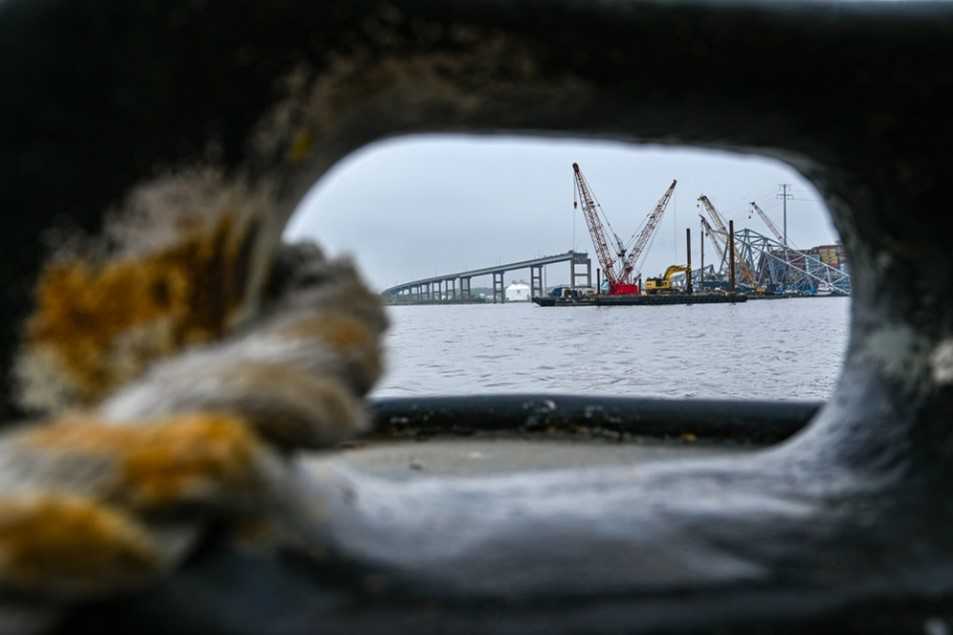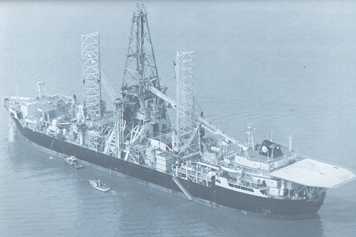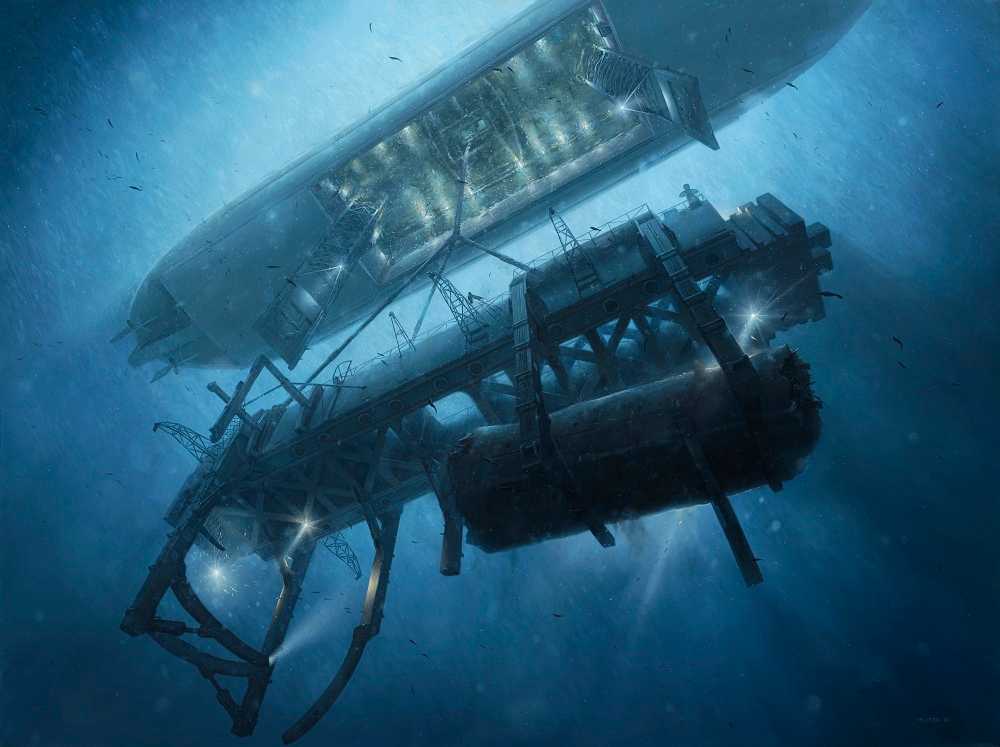Imagine that you are standing on top of the Empire State Building in New York City with a 1-inch-diameter steel rope that has an 8-foot-wide grappling hook attached to the end. You must lower the hook to the street below, snag a small car that’s filled with gold, and lift the car to the top of the building… all without anyone noticing.
That’s how we like to describe one of CIA’s most audacious Cold War missions, codenamed Project AZORIAN. CIA commissioned the construction of a 600-foot ship, the Hughes Glomar Explorer, and used it to secretly pluck a Soviet nuclear submarine off the ocean floor using a huge claw.
While the Hughes Glomar Explorer no longer exists, a unique floating crane that was instrumental in helping to build the legendary ship—making the entire mission possible—found itself at the center of another technologically complex mission: removing sunken, tangled metal from the tragic 2024 collapse of the Francis Scott Key Bridge in Baltimore, Maryland.

Clean-up of Baltimore’s Francis Scott Key Bridge collapse. Photo taken April 18, 2024, courtesy of U.S. Navy Mass Communication Specialist 2nd Class Theodore C. Lee.
The Baltimore Bridge Collapse
In the pre-dawn hours of March 26, 2024, a cargo ship named the Dali set sail for Sri Lanka from the Port of Baltimore in Maryland. It lost power, suffering a complete blackout, and crashed into the Francis Scott Key Bridge, sending eight construction workers and almost 50,000 tons of twisted steel and concrete plunging into the freezing, dark waters of the Patapsco River. Six construction workers lost their lives in the disaster, and one of the busiest maritime ports in America was shut down, blocked by debris.
This is where “Chessy,” the largest crane on the Eastern seaboard of the United States, came in.

The Chesapeake 1000 crane in Baltimore Harbor on March 29, 2024. Photo courtesy of U.S. Navy Mass Communication Specialist 2nd class Hannah Mohr.
Officially known as the Chesapeake 1000—named for the 1000 tons the crane can lift—Chessy, along with several smaller cranes and salvage barges, was put in charge of removing, piece-by-piece, heaps of tangled metal and crumpled concrete from the murky waters. It was a complicated mission that lasted several months because salvage crews were dealing with entwined, gigantic pieces of steel that had to be carefully separated into manageable sections. They also had to free the Dali cargo ship, because it was trapped beneath the ruins of the bridge.
Chessy’s mission was a success. “I’ve been waiting to say this for every day for the last 11 weeks,” announced Maryland’s Governor Wes Moore at a press conference on June 12, 2024. “The Fort McHenry Channel is fully cleared, and the Port of Baltimore is reopened for business.”

Specs for the Sun 800 from an old brochure created by Sun Shipbuilding in the 1970s.
The Sun 800
[NOTE: Although Chessy the crane is clearly an inanimate object, cranes—like ships—are traditionally referred to with female pronouns. As Chessy/Sun 800 is the main character of this tale, we decided to follow this historic, traditional convention.]
Chessy, when CIA knew her, was called the Sun 800.
It was 1972, and CIA contracted with the business Sun Shipbuilding and Drydock Company to build the crane as part of what became known as Project AZORIAN. Once built, the Sun 800 could lift more than any other crane in existence: 800 tons.
This was vital because the key to Project AZORIAN was building a gigantic ship called the Hughes Glomar Explorer, and the Agency needed a powerful crane to construct the ship.
According to a retired CIA DS&T officer who worked on Project AZORIAN, the crane was used to install a gimbal platform on the Glomar Explorer, a feat that would have been impossible without the Sun 800. “The gimbal platform was probably the single heaviest piece of equipment on the Glomar,” he remembers. “The gimbal, along with the heave compensator [a system used to reduce the effect of waves upon lifting and drilling equipment while at sea], were the key pieces of equipment that made the CIA operation feasible.”

The Sun 800 crane hoisting the 630-ton gimbal platform onto the Hughes Glomar Explorer. Early 1970s.
Glomar and Project AZORIAN
Glomar’s story began in 1968 when a Soviet Golf II-class submarine carrying three SS-N-4 nuclear-armed missiles sailed from a naval base on Russia’s Kamchatka Peninsula enroute to its peacetime patrol station northeast of Hawaii. Shortly after leaving port, the submarine and its crew disappeared. After an extensive, but unsuccessful effort, the Soviets abandoned the search.
Little did they know, however, that the U.S. had located the submarine resting on the ocean floor about 1,500 miles northwest of Hawaii.
With support from the Department of Defense—and recognizing the opportunity to glean information on Soviet strategic capabilities—CIA agreed to lead a recovery effort.

The Hughes Glomar Explorer. Early 1970s.
Officers from CIA’s Directorate of Science and Technology (DS&T) faced a daunting task: lift the huge 1,750-ton, 132-foot-long wrecked submarine intact from an unknown ocean abyss more than three miles below the ocean surface—under total secrecy.
A team of Agency engineers and contractors determined the only technically feasible approach to recover the Soviet submarine was to use a large mechanical claw—affectionately named “Clementine”—attached to a ship’s surface to lift it. Such a ship had to be specially constructed, hence the need for the giant Sun 800 crane to help bring this crazy mission to life.

Illustration showing how the capture device with mechanical claw would lift the Soviet submarine.
In order to maintain operational security, CIA reached out to billionaire Howard Hughes, who agreed to work with the Agency to build a plausible cover story. The ship would be named the Glomar Explorer, a commercial deep-sea mining vessel ostensibly built and owned by Hughes. Hughes provided the necessary cover, asserting that the Glomar Explorer and its crew were conducting marine research at extreme ocean depths and mining manganese nodules lying on the sea bottom.
The Glomar Explorer arrived over the recovery site on July 4, 1974, and conducted salvage operations for more than a month under total secrecy—despite much of the time being monitored by nearby Soviet ships curious about its mission.
During the lift, when the submarine was a third of the way up, it broke apart, and a section plunged back to the ocean bottom. Crestfallen, the Glomar crew successfully hauled up just the portion that remained in the capture vehicle.
Almost immediately after the recovery effort, planning began for a second mission to recover the lost section. However, just before Glomar set off to collect the remaining portion of the submarine left behind on the ocean floor, the cover story for the daring operation was publicly exposed.
National headlines disclosed that billionaire Howard Hughes was not actually undertaking a commercial deep-sea mining expedition, and instead it was a CIA operation to salvage a Soviet submarine. With that, Project AZORIAN came to an end.

Painting of the Hughes Glomar Explorer from CIA’s Intelligence Art Collection.
The Sun Rises Again
Although Project AZORIAN did not meet its full intelligence objectives, CIA considers the operation to be one of the greatest intelligence coups of the Cold War. Intelligence collected from the operation provided a significant contribution to the U.S.’s broader understanding of Soviet strategic capabilities.
Project AZORIAN was also a DS&T engineering marvel that advanced state-of-the-art deep-ocean mining and heavy-lift technologies.
The Hughes Glomar Explorer itself had a second life as a legitimate drillship, working ocean wells for over 15 years. Glomar’s last owner, Transocean, retired the ship in 2015 after its technology was too outdated to be of value. Unfortunately, Glomar was sent to China and scrapped. But the crane survived.
In addition to building the Glomar Explorer, the Sun 800 helped facilitate many other unique shipbuilding possibilities and has been used in a wide range of applications over the last 52 years, including construction, marine salvage, and cargo handling.
According to the Sun Ship archives, the Sun 800made her biggest lift in 1978 when she placed the 788-ton draw-span onto the Benjamin Harrison Bridge in Hopewell, Virginia.
When Sun Shipbuilding sold its yard in 1982 to Penn Ship, the Sun 800 was also transferred to the new owner and renamed the Penn 800. She sustained damage during a storm off the East Coast but instead of scrapping her, repairs were made, and she was upgraded to 1,000 tons and rechristened the Penn 1000. When Penn Ship closed, she once again was sold—this time to Donjon Marine in 1993—and that’s where she got her current name, the Chesapeake 1000, aka “Chessy.”
From secret spy missions to disaster recovery, it is a humble crane whose legacy continues to unfold to this day.
So where is Chessy now and what is her next mission? That’s intel we can neither confirm nor deny.
